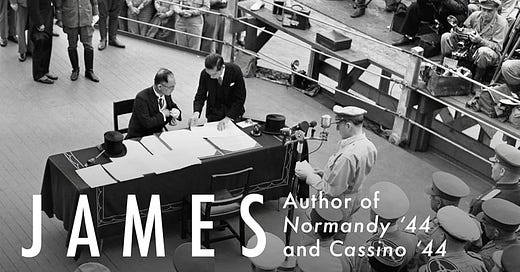This review will in due course find itself in the pages of the Aspects of History magazine, but for my dedicated readers, I thought I’d let you have my view of this new book now.
Its quite simply… brilliant!
It’s is what you get when you marry two first-class historians (and communicators) of the Second World War. I enjoyed its pace, its story-telling and the sheer enthusiasm these two characters have for their subject. Despite its subject matter, it was fun. The combination of Murray and Holland is a marriage made in heaven, as afficionados of the We Have Ways phenomenon will readily attest.
Not long ago James asked me how I managed to collaborate with someone else in writing a book: my last two books have been written with General Lord Dannatt. I told him that it was easy, as it halved the work load and doubled the brain power required to produce 120,000 reasonably sensible words every 12-months in a competitive field. He’s clearly taken my advice, and this is the result.
The subject is quite brilliant too. How many new ways can one find to look at the greatest ever drama in human history? Well, this spectacular duo has found it: the ending of the war, rather than its beginning or its middle (both of which James has dealt with in detail in the two volumes of his War in the West). Its always the hardest thing to do (ending a war that is; starting one is quite easy in comparison), so its fascinating that so few historians have ever examined the end of the Second World in its granular detail, from a holistic (i.e. all the surrenders taken into consideration) and a narrative (storytelling) perspective. The secret to this book’s success is that both writers have grasped its sheer human drama. Imagine what General Wainwright must have been thinking when he was mobbed by 100,000 compatriots on the White House lawn after his three years of brutal captivity? Yet he shed tears for General Yamashita when the Tiger of Malaya was marched of to his trial and execution. Extraordinary.
James Holland has demonstrated that he is as forensic an historian as any in the hallowed halls of academia (look at Italy’s Sorrow for an example of what I mean) while Al Murray is the perfect chatty-man (or pub landlord?), without losing any profundity by being so. They’ve both perfected the art of telling stories. The fusion of these two voices gives us a fast-paced human-filled drama of the road to the end of the war across the globe (from Rome to Berlin, Luneburg Heath and Tokyo) through many of the voices of many of those involved, high and low. It‘s not comprehensive (there is no surrender of the Japanese to Marshal Zhukov in Manchuria for instance) but this isn’t a criticism: there is only so much of this story of the end of the way one can tell, and writers (as I regularly insist) are their own masters: they are free to pick and choose what stories they tell. But its the stories of Wainwright and others contrasting with the nasty fascists Donitz, Kesselring, Keitel and Kaltenbrunner that had me hooked. But the heroes were those who saw, and survived to tell their stories: Yelena Kagan, Helmut Altner, Hugo Gryn, Alan Moskin and many others all had me spellbound. After all, war is primarily about the people who are forced to fight it, especially those who do so out of duty or service rather than passion or nationalist or ideological conviction. Holland and Murray have scooped the prize on telling person-centric narratives about the greatest drama on earth.
Bravo!
The only problem? I’m now looking forward to the next foray, knowing that it will be at least a year away.
Come on boys!





If I hadn't had Pre-ordered this all ready I would definitely be buying a copy after your excellent review. Al and James are both great historians and like you say storytellers, read many of their works (and yours) the We Have Ways podcast and festival is testament to their abilities to engage with people of the same affliction but also the ability to engage with people with very little interest in this subject.
An excellent book, Robert. I walked into Waterstones Shrewsbury this week armed with a birthday voucher, to walk out with a signed copy of the book, which I am thoroughly enjoying. A quick aside, I just finished reading about the fascinating life of Adrian Carton de Wiart; a larger-than-life character would be an understatement. My immediate thought was: did George MacDonald Fraser use him to develop Flashman?